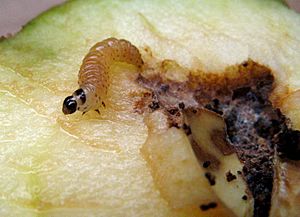Cydia (moth) facts for kids
Quick facts for kids Cydia (moth) |
|
|---|---|
 |
|
 |
|
| An adult codling moth (C. pomonella) (above) and its caterpillar (below) | |
| Scientific classification |
|
| Kingdom: | Animalia |
| Phylum: | Arthropoda |
| Class: | Insecta |
| Order: | Lepidoptera |
| Family: | Tortricidae |
| Tribe: | Grapholitini |
| Genus: | Cydia Hübner, 1825 |
| Type species | |
| Phalaena (Tortrix) pomonella Linnaeus, 1758
|
|
| Diversity | |
| About 215 species (but see text) | |
| Synonyms | |
|
Numerous, see text |
|
Cydia is a large group of moths. They belong to a family called Tortricidae, also known as tortrix moths. These moths are usually small and dull brown. Their caterpillars are often yellow or white and look like worms.
Many Cydia species are important because their caterpillars can be pests to farm crops. They especially like to damage fruit and nut trees. For example, the codling moth (Cydia pomonella) is a well-known pest of apple trees.
On the other hand, some Cydia species are helpful! They are used in biological control to fight against invasive weeds. This means they help control plants that grow where they are not wanted. Also, these small moths and their caterpillars are a good food source for other animals. Sadly, a few species from the Hawaiian Islands might be extinct. This happened because their food plants disappeared.
One very famous Cydia species is the jumping bean moth (C. saltitans). Its caterpillars live inside the seeds of a plant called Sebastiania. When the caterpillars move inside the seeds, they make them "jump"! These are the famous "Mexican jumping beans."
Many kinds of Cydia moths
There are about 215 different kinds of Cydia moths known today. Scientists are still studying them, so this list might change. Here are a few examples:
- Cydia amplana – known as the rusty oak moth
- Cydia caryana – known as the hickory shuckworm moth
- Cydia chlorostola (possibly extinct)
- Cydia pomonella – the famous codling moth
- Cydia duplicana
- Cydia fagiglandana – known as the beech moth
- Cydia gypsograpta (possibly extinct)
- Cydia ingens – known as the longleaf pine seedworm moth
- Cydia kurokoi – known as the nut fruit tortrix
- Cydia latiferreana – known as the filbertworm moth
- Cydia leucostoma – known as the tea flush worm
- Cydia medicaginis – known as the alfalfa moth
- Cydia millenniana – known as the larch gall moth
- Cydia nigra
- Cydia nigricana – known as the pea moth
- Cydia piperana – known as the ponderosa pine seedworm moth
- Cydia pyrivora – known as the pear fruit moth
- Cydia saltitans – the jumping bean moth
- Cydia splendana – known as the chestnut tortrix or acorn moth
- Cydia storeella (possibly extinct)
- Cydia strobilella – known as the spruce seed moth
- Cydia succedana
- Cydia toreuta – known as the eastern pine seedworm moth
- Cydia ulicetana
- Cydia zebeana – known as the larch bark moth
Images for kids
See also
 In Spanish: Cydia para niños
In Spanish: Cydia para niños



